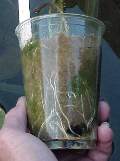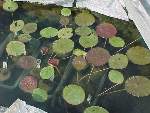Our Adventure With Victoria 2001
Click images to enlarge

Late in 2000, we began to think we were giving too much fertilizer to our Victorias, a turn around from the idea that "You can't overfeed Victoria". We had always been told that and fully subscribed to the notion. Why then were perfectly healthy plants declining? Symptoms included rim breakdown, premature deterioration of mature pads, poor color and failure to thrive.
 We
stopped feeding the Vics entirely for a short time and resumed
light feeding when we saw an improvement. We very gradually increased
the amount to what seemed to be a balance between too little
and too much but, because it was late in the season and the plants
were losing size anyway, our experiments were limited.
We
stopped feeding the Vics entirely for a short time and resumed
light feeding when we saw an improvement. We very gradually increased
the amount to what seemed to be a balance between too little
and too much but, because it was late in the season and the plants
were losing size anyway, our experiments were limited.
We brainstormed this with anyone who seemed to have any clue about nutrients and two things became obvious. The symptoms were similar to starvation and we had never considered soil type a factor in nutrition. We're hobbyists - what do we know? We decided we needed at least some basics in this.
The soil spectrum has sand at one end and clay at the other, sand binding almost no nutrients and clay binding many. All soils are sand, clay and loam in some proportion, though it would be hard to detect any clay or much loam in our just-better-than-beach-sand. Tropical waterlilies thrive in it though we supplement them with PondTabbs on a regular schedule. Victorias have done fine (we thought) though we never have achieved the pad size found elsewhere - not exactly a problem since our space is limited.
This WAS a concern in 2000 since the species plants were out of synch for making the hybrids. If an amazonica was blooming cruziana wasn't and vice versa. Our first inclination had been to pour on the fertilizer, exacerbating the problem, and then to back off, which helped. (Another factor was at work here - see "The Cruziana Clock") We did not want to experience another poor production year like that.
Since Victoria has really been viewed as a novelty outside of a few major botanic gardens and documentation of growth and health even from those is sparse to nonexistent, what basis could we use for determining normal? They grow, with luck they flower, with even more luck they make seeds and they die. By now we have grown enough Victorias and collected enough data to notice if one, more or all are in trouble. Sometimes they thrive by luck and chance but there must be a way to make it less of a crap shoot.
Over time we learned that in sand nutrients either go straight to the plants or are quickly dissipated in the water. Since the problematic symptoms looked very like nitrogen and iron deficiency, we began to wonder if they WERE nitrogen and iron deficiency, even though plenty of those elements are present in most aquatic formulations including our beloved PondTabbs. What if something in these fertilizers was actually locking up other nutrients, preventing their uptake by the plants? The bottom line answer was yes, this was possible. Why for Victoria and not for tropical waterlilies? Different nutritional needs.
In 2001, the first thing we tried was supplementing our now
carefully controlled weekly application of PondTabbs to the Victorias
with Shultz Iron Green, a liquid 8-0-0 with iron and magnesium.
We saw improvement but not a complete fix, especially in cruziana.

Two people played key roles in helping us determine and implement our current nutrient program, Andre Leu and Wayne Davis. As a grower of exotic tropical fruit in Australia (as well as an avid aquatics enthusiast) Andre was up on what he called "the cutting edge of agronomy" being studied there. Enter biostimulants, non-nutritive environmentally friendly growth enhancers that act in concert with regular fertilizers to improve nutrient uptake and general plant health.
We searched the Web and found a number of sites devoted to information about biostimulants. All are natural and include such things as kelp, humic acid, fulvic acid, alfalfa and vitamins. These can be acquired individually and sometimes in combination. We experimented with individual components separately with poor results. Combinations were better and the best of these that we found was "Roots"TM , developed at Yale University.
The more we learned the more excitied we got and were soon on the phone to Wayne Davis of PondTabbs, also sending the URLs of biostimulant sites to him by email. Wayne too was just learning about this new approach and soon sent us a granular product to try. Since the plants were already installed we found this hard to apply and slow to act. The liquid "Roots" could be injected into the soil along with the Iron Green.
Andre also encouraged us to try fish emulsion as a fertilizer with the biostimulants. We found, in numerous experiments, that neither fish emulsion nor PondTabbs did as well as a combination of both. We tried various proportions of the elements in our cocktail and finally found a mix that gave consistent results for most plants. Overall "dose" for each plant was determined by a rather complicated formula based on total pad surface area.
There is no doubt in our minds that, at least in our sand, Victoria has a higher nitrogen, iron and possibly magnesium requirement than other waterlilies. We also have no doubt that use of a biostimulant allows all nutrients to be better utilized, promoting improved general health, larger longer lasting pads, larger flowers and even more and larger seeds. Our numerical records prove it. We are now seeing evidence that this carries on to the next generation as well.
Our cruzianas still were not totally happy. Though they were blooming and somewhat maintaining size, their color still was not great. We decided to try giving some of them the liquid part of our cocktail in the middle of the week on top of their weekend total feeding. Those receiving it improved dramatically so we abandoned the experiment and gave it to all. We can only conclude that cruziana has an even higher nitrogen and iron requirement than amazonica and the hybrids.
While we were experimenting and feeding our results back to Wayne, he had been busy too! He sent us an excellent biostimulant to test and the plants loved it. Even though we were well into fall and many plants were shrinking, our biggest 'Adventure' began producing the largest pads we have ever had. The other plants responded as well. "Seamate" is being made available by PlantTabbs Products as we write this.
For each PondTabb poked near the crown of the plant, we inject with 16 guage needle and large syringe 5 cc of the following mixture:
4 tablespoons Schultz Iron Green
2 tablespoons Fish Emulsion
5 tablespoons "Roots" or 3 tablespoons "SeaMate"
Enough water to make 1 cup
We have also found a more dilute version of the "cocktail"
successful with Victoria babies. We give 1/2 to 1 cc weekly
to those in 3 ounce cups, 2-4 cc to those in 9 ounce cups depending
on plant size and 10-15cc to those in 6 inch pots. The mixture
is:
In 1 cup of water
1 t Schultz Iron Green 8-0-0
1/2 t fish emulsion 4-1-1
1 1/2 t biostimulant ("Roots") or 1 t Seamate
1/6 PondTabb or 1 PondTabb Junior dissolved
We'll finish this chapter by mentioning that, all along the way, we have had to fight the tendency to feel (and try) "if a little is good, more is better." This is NOT the case. Biostimulants, just as with the other cocktail ingredients, must be applied at recommended rates.
Links to learn more about biostimulants --
|
|
|
|
Seeds of the Century | Dissection of V. amazonica
1999 The Adventure Continues | 2000 A Very Bad Year | 2001 A Banner Year
2002 An Even Better Year | 2003 We Like It Like This | 2004 Trust
2005 Recovery | 2006 Normal? | 2007 Weird | 2008 Year of the Hare
2009 Year of the (White) Tortoise